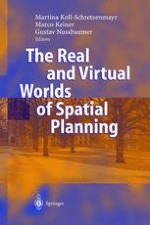
2004 | OriginalPaper | Buchkapitel
Editors’ Introduction
verfasst von : Martina Koll-Schretzenmayr, Marco Keiner, Gustav Nussbaumer
Erschienen in: The Real and Virtual Worlds of Spatial Planning
Verlag: Springer Berlin Heidelberg
Enthalten in: Professional Book Archive
Aktivieren Sie unsere intelligente Suche, um passende Fachinhalte oder Patente zu finden.
Wählen Sie Textabschnitte aus um mit Künstlicher Intelligenz passenden Patente zu finden. powered by
Markieren Sie Textabschnitte, um KI-gestützt weitere passende Inhalte zu finden. powered by
In his famous philosophical doctrine, the so-called ‘Theory of Forms,’ Plato distinguished between an invisible Universe of Higher Reality that constituted the unchanging and determinate ‘forms’ of all things and a Visible World of change and flux that is only a copy or reflection of the Universe of Higher Reality. According to Plato’s Theory of Forms, true and certain knowledge can only be obtained from the Universe of Higher Reality, whereas the Visible World of experience, i.e., the real world we live in, cannot produce true or certain knowledge. Plato’s “idea of explaining the visible world by a postulated invisible world” invented “a new approach towards the world and towards knowledge of the world” (Popper 1963:89) by explaining visible matter with theories about invisible structures. However, theories can describe even ‘deeper layers of reality’ that are not ‘real matter’ but are of a hypothetical character, for example, forces, fields of forces, or, in a more general sense, interaction.